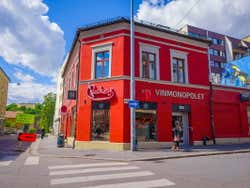
Grünerløkka
Street music, alternative pubs, exhibitions of local artists .... Grünerløkka is Oslo's trendiest area and an excellent district for discovering the other side of the capital.
History
During the 19th century, large factories and workers' housing were built in the northwest of Oslo, giving rise to the Grünerløkka district. Its proximity to the Akerselva River led to the expansion of industry in this district and Grünerløkka became a working-class area.
As the Industrial Revolution wore on, the district became a residential area for working-class families. It was in this environment that the young Edvard Munch was born and raised. Visiting Grünerløkka is like travelling back to visit the childhood of the famous Norwegian artist, and although the houses where Munch lived cannot be visited, the buildings here still retain their original facades. If you're interested in the life and work of this artist, you can visit the Munch Museum in the vicinity of Grünerløkka.
Throughout the 20th century, the neighbourhood underwent a major transformation and became the main centre of street art. The streets of Grünerløkka were covered with graffiti and murals, vintage clothing shops opened on the main avenues of Grünerløkka, and the neighbourhood was filled with street musicians.
Today, Grünerløkka is a nightlife and party hotspot.
Oslo's alternative neighbourhood
Grünerløkka is undoubtedly Oslo's trendiest neighbourhood. It's a great place to shop for second-hand goods, antiques or vintage clothes in small boutiques.
Grünerløkka is also the best area in Oslo to enjoy live music, either on the street or in the many cafés and taverns scattered throughout the neighbourhood.
If you feel like enjoying the quieter side of Oslo, a stroll along Grünerløkka along the banks of the Akerselva River is the best way to do so.


Transport
Tram: lines 11, 12 and 13
Nearby places
Munch Museum (1 km) Oslo Cathedral (1.7 km) National Gallery of Norway (1.8 km) Oslo Opera House (2 km) Oslo City Hall (2.2 km)

